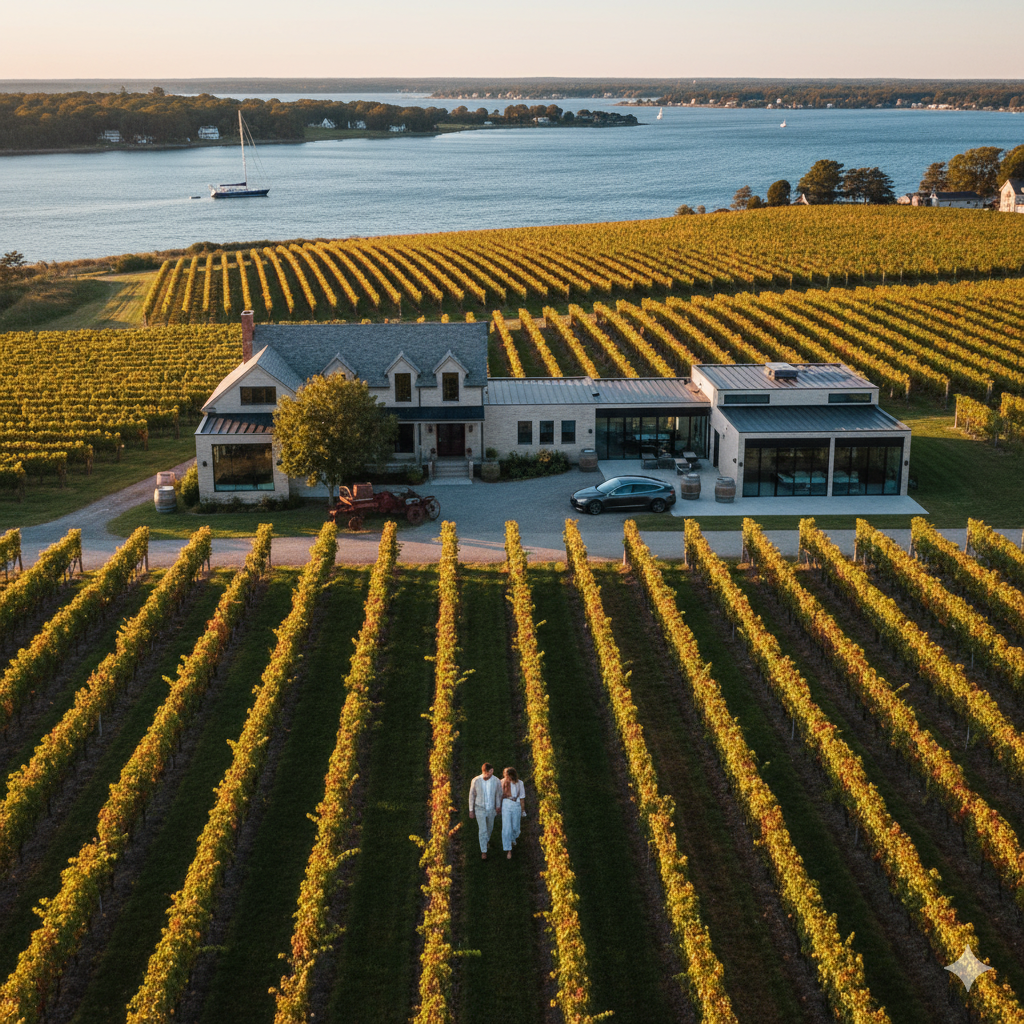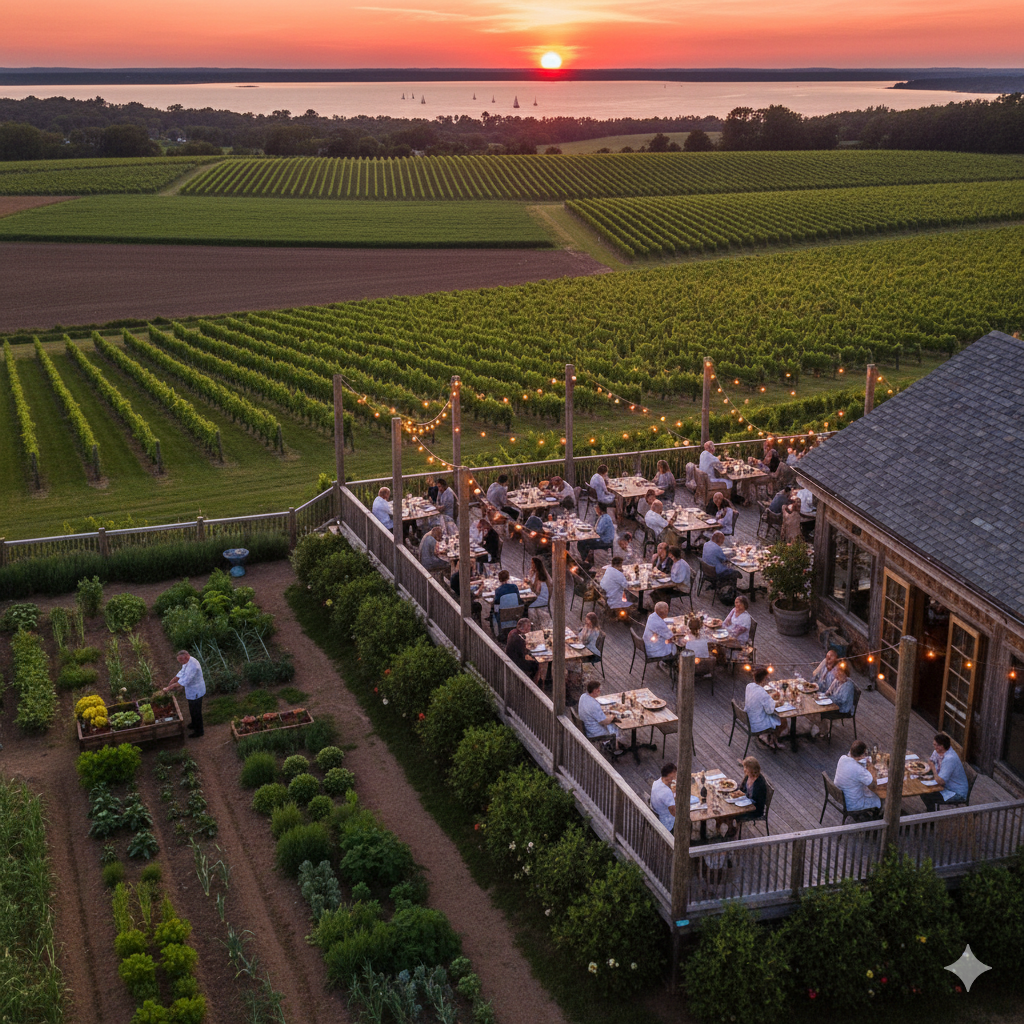Here’s the dirty little secret wealthy New Yorkers don’t want you to know: while they’re fighting over fifteen-thousand-dollar summer shares in Southampton, the real power players have quietly colonized Long Island’s North Fork. Unlike the Hamptons’ circus of social climbing and see-and-be-seen theatrics, this Guide to North Fork reveals a place where old money whispers instead of shouts.
The Geography of Sophistication
The North Fork stretches approximately thirty miles from Riverhead to Orient Point, surrounded by water that creates what locals call “the terroir advantage.” The Long Island Sound borders the north, while Peconic Bay defines the southern boundary. This maritime influence produces the same microclimate that makes Bordeaux legendary, except here you can drive from Manhattan in ninety minutes.
What started as potato farms in the 1980s has evolved into New York’s premier wine region. Moreover, this transformation happened while everyone was looking elsewhere. The North Fork operates on what behavioral economists call “selective attention” – the smart money moved in while the masses were distracted by Hamptons glamour.
The Wine Intelligence Network
Understanding North Fork wineries requires abandoning Hamptons thinking entirely. Furthermore, these aren’t party venues; they’re agricultural businesses run by families who understand that sustainable luxury beats flashy trends every time.
Macari Vineyards exemplifies this philosophy. Founded in 1995, their 500-acre estate follows biodynamic principles using composted fish waste from local markets. When everyone else was following chemical-heavy farming manuals, the Macari family chose environmental stewardship. Today, their decision looks prescient as sustainability becomes the ultimate luxury credential.
Paumanok Vineyards tells a similar story. Charles and Ursula Massoud founded this operation in 1983 when Long Island was still potato country. Their 1997 Late Harvest Riesling was served at the White House for NATO’s 50th anniversary, cementing their reputation among those who actually matter.
Meanwhile, RGNY represents the new wave of international investment. The González family brought Mexican winemaking expertise to their former Martha Clara Vineyards property. As their international sales director puts it: “Long Island is not a place for formula wines. The weather changes year to year, as do the wines.”
Farm-to-Table: Beyond the Buzzword
North Fork’s culinary scene operates on a completely different frequency than typical restaurant marketing. These establishments don’t need to advertise “farm-to-table” because they literally exist within the farm ecosystem. Consequently, ingredients travel yards, not miles.
North Fork Table & Inn remains the region’s crown jewel. Under Michelin-starred chef John Fraser’s direction, this institution demonstrates how vegetables can be the star, not the supporting cast. Fraser’s vegetable-centric approach reflects what sophisticated diners already know: proteins are expensive, vegetables are profitable.
Love Lane Kitchen in Mattituck represents the more casual end of the spectrum. Their rustic farm-to-table approach serves everything from decadent pastries to farm-fresh dinners. However, don’t mistake casual for cheap – their lobster roll commands premium prices because it delivers premium value.
Additionally, Jamesport Manor Inn offers elegant dining deeply rooted in the local community. Their seasonal menu changes reflect what actual availability looks like, not what marketing departments think sounds appealing.
The Accommodation Hierarchy
North Fork lodging follows the same principle as everything else here: substance over surface. These aren’t resorts designed for social media; they’re strategic bases for people who understand real luxury.
The Menhaden in Greenport offers contemporary décor and stunning views without the pretension. Their boutique approach caters to guests who appreciate design that doesn’t scream for attention. Similarly, Sound View Inn provides beachfront access with Long Island Sound views, perfect for those who prefer private beaches to public spectacle.
Furthermore, Hotel Indigo in Riverhead serves as an upscale base for serious wine touring. Located strategically for winery access, it attracts guests whose primary interest is terroir, not Instagram opportunities.
Strategic Timing and Access
The smartest operators understand that timing determines value in North Fork just like financial markets. March offers quieter, more intimate experiences compared to summer’s crowds. However, fall provides harvest energy that serious wine enthusiasts prefer.
Access requires planning, especially for premium experiences. Many tasting rooms fill quickly on weekends, and the best restaurants require advance reservations. This isn’t accidental – scarcity creates value.
Transportation options include driving from NYC (90 minutes), Long Island Rail Road to Greenport, or the scenic ferry from Connecticut. Each method sends different signals about your priorities and resources.
The Farm Stand Network
North Fork’s agricultural infrastructure operates like a luxury supply chain. Catapano Dairy Farm produces artisanal goat cheese that rivals European imports. Meanwhile, Sang Lee Farms supplies organic produce to Manhattan’s finest restaurants.
These operations understand something most businesses don’t: controlling the supply chain controls the profit margins. When you buy directly from producers, you’re accessing wholesale prices for retail quality.
Cultural Capital Conversion
Greenport functions as North Fork’s unofficial capital, demonstrating how maritime heritage translates into modern cultural currency. The harbor town’s boutique shops and waterfront restaurants create an authentic alternative to Hamptons artifice.
Moreover, the art scene operates quietly but significantly. Galleries like RJD showcase serious artists who choose Long Island for its historical depth rather than social advantages.
Investment Implications
Understanding North Fork as an investment thesis requires recognizing convergent trends. Climate change makes northern wine regions more valuable. Urban flight accelerates agricultural land appreciation. Additionally, sustainability consciousness drives luxury consumer preferences.
Smart money recognizes these patterns. Consequently, North Fork real estate prices remain reasonable compared to Hamptons madness, but probably not for long. The region offers what economists call “asymmetric opportunity” – limited downside with substantial upside potential.
The Seasonal Advantage
North Fork’s year-round appeal contrasts sharply with Hamptons seasonality. Winter provides intimate tasting experiences and cozy restaurant atmospheres. Spring offers wine events and agricultural awakening. Summer delivers perfect weather without overwhelming crowds.
However, fall represents peak sophistication. Harvest season combines agricultural authenticity with culinary excellence, attracting serious food and wine professionals rather than social tourists.
Navigating the Network
Success in North Fork requires understanding its social architecture. Unlike Hamptons networking, which operates through conspicuous consumption, North Fork relationships build through shared appreciation for craft and quality.
Consequently, the most valuable connections happen naturally through wine tastings, farm visits, and restaurant conversations. These aren’t transactional relationships; they’re based on genuine shared interests.
Furthermore, local knowledge compounds over time. Regular visitors develop relationships with winemakers, farmers, and restaurant owners that provide access to limited releases, private tastings, and off-menu experiences.
The Excellence Standard
North Fork operates on what quality experts call “tacit knowledge” – understanding that can’t be easily copied or commoditized. Winemakers like Kareem Massoud produce “minimalist cabernet franc” fermented with wild yeast and no added sulfites, creating expressions impossible to replicate industrially.
This artisanal approach extends throughout the region. Consequently, North Fork products command premium prices because they deliver unique value impossible to mass-produce.
The Strategic Conclusion
This Guide to North Fork reveals a region positioning itself as the anti-Hamptons – sophisticated without ostentation, exclusive without pretension. While social climbers chase Hamptons status symbols, serious wealth builders are quietly establishing North Fork foundations.
The mathematics are compelling: better value, authentic experiences, and sustainable growth potential. Moreover, you can actually park your car and walk to dinner without hiring security.
North Fork represents what luxury becomes when it matures beyond mere display. It’s where people go when they no longer need to prove anything to anyone. Which, coincidentally, is exactly when they become most worth knowing.
The question isn’t whether you can afford North Fork. It’s whether you’re sophisticated enough to appreciate what it offers.
Related Stories
- Heated Outdoor Dining Options for Long Island and New York City
- DJ Logan’s Run Curates Perfect Hamptons Playlist
Connect With Social Life Magazine
For advertising and editorial submissions, visit www.sociallifemagazine.com/contact.
Subscribe to exclusive email invites and special offers: Join Our VIP List
Subscribe to our print magazine: Print Subscription






